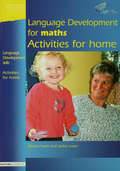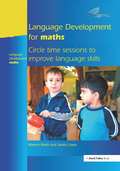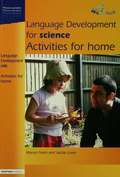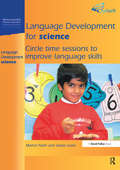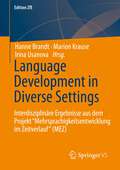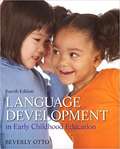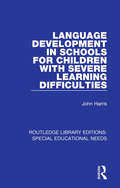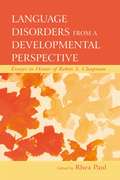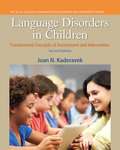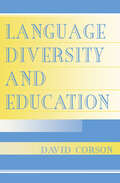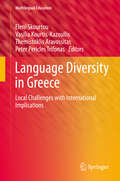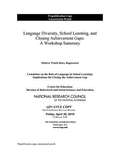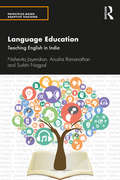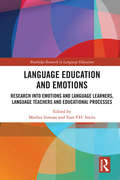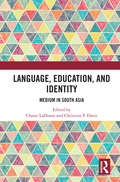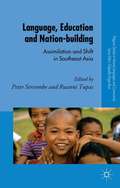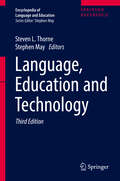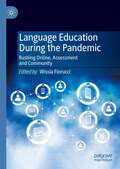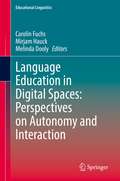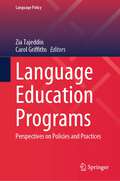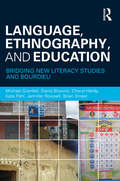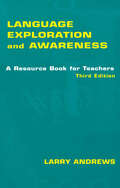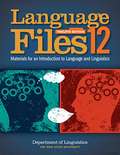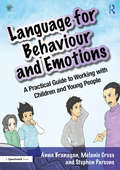- Table View
- List View
Language Development for Maths: Activities for Home
by Marion Nash Jackie LoweBuilding upon the successful 'spirals' programme this series of books addresses language development in three core areas of the curriculum. Linking the work done in school with the simple games and activities to be used at home. All activities have been tried and tested - proven effectiveness. the video CD with teachers' book contains explanations and demonstrations of the programme and its implementation, with comments from the staff who have used it.
Language Development for Maths: Circle Time Sessions to Improve Communication Skills in Maths
by Marion Nash Jackie LoweBuilding on the successful 'spirals' programme this series of books addresses language development in the three core areas of the curriculum. Linking the work done in school with simple games and activities to be used at home. All activities have been tried and tested - proven effectiveness. A video CD contains explanation and demonstration of the programme and its implementation, with commetns from staff who have used it.
Language Development for Science: Activities for Home
by Marion Nash Jackie LoweThese simple play-based activities are ideal for teachers to copy and give out to parents who want to know how to help their child improve his or her science language skills and have fun at the same time. Activities are linked directly to the school-based Language Development Circle Time sessions, but can also be used independently. There is a clear structure and progression of ideas, with supporting black-line drawings to acts as prompts and simple record - keeping system to support home/school communication.
Language Development for Science: Circle Time Sessions to Improve Language Skills
by Marion Nash Jackie LoweThis book is the first of its kind to help practitioners specifically develop children's language skills in Science. The book incudes: guidelines to help teachers set up, run and assess circle-time sessions ideas for promoting children's thinking skills and emotional literacy video CD containing explanation and demonstration of the programme and its implementation, with comments from staff who have used it.
Language Development in Diverse Settings: Interdisziplinäre Ergebnisse aus dem Projekt "Mehrsprachigkeitsentwicklung im Zeitverlauf“ (MEZ) (Edition ZfE #11)
by Hanne Brandt Marion Krause Irina UsanovaDer Band präsentiert interdisziplinäre Befunde zur Relevanz von Mehrsprachigkeit für die Bildungsbiografien von Schülerinnen und Schülern in Deutschland. Im Fokus stehen sprachliche, persönliche und kontextuelle Faktoren, die die sprachliche Entwicklung von Lernenden beeinflussen können. Dabei kommen sowohl quantitative als auch qualitative Methoden zum Einsatz.
Language Development in Early Childhood Education
by Beverly W. OttoWritten by Beverly Otto, Language Development in Early Childhood Education, 4/e efficiently combines theory, research, and practice to provide a solid foundation for understanding language development in children birth through age eight. A comprehensive resource, it focuses on the development of phonological, semantic, syntactic, morphemic, and pragmatic language skills, children's understanding of written language, and ways in which this acquisition process can be enhanced in early childhood settings. Exact guidance on how to develop classrooms and other learning environments that enhance children's language development is also provided. Every chapter begins with interesting vignettes of young children's language development, and throughout all the chapters, readers will discover anecdotal narratives to illustrate key concepts and interaction strategies.
Language Development in Schools for Children with Severe Learning Difficulties (Routledge Library Editions: Special Educational Needs #31)
by John HarrisFirst published in 1988. Language is an important developmental ability which facilitates communication both at home and at school. It is also the foundation of many of a child’s learning experiences in school. A certain level of language is often a pre-requisite both for success in particular curriculum areas and for the ability to conceptualise generally. Language developing is thus a major concern for those who work with mentally handicapped children and it has come to be regarded as one of the main objectives within the special school curriculum. This book is concerned with the opportunities for language learning which special schools make available for severely mentally handicapped children. It describes how special schools seek to meet the very diverse needs of their pupils and provides a discussion of the success of contemporary approaches to encouraging language development. The author makes a number of constructive criticisms and suggestions for improving practice which should interest anyone whose work involves teaching children with severe learning difficulties.
Language Disorders From a Developmental Perspective: Essays in Honor of Robin S. Chapman (New Directions in Communication Disorders Research)
by Rhea PaulThe last 25 years have witnessed an explosion of research at the intersection of typical language development and child language disorders. A pioneer in bringing these fields of study together is Robin S. Chapman, Emerita, University of Wisconsin. This contributed volume honors her with chapters written by former students and colleagues, who track in their own research the theme of psycholinguistic contributions to our understanding of the nature and remediation of child language disorders. In this volume, such renowned researchers in child language development as Dorothy Bishop, Judith Johnston, and Ray Kent, among others, discuss their research in certain populations in the context of the significance of, limits of, and alternatives to Robin Chapman’s developmental interactionist perspective. Studies of disordered language in Down’s Syndrome and Specific Language Impairment, in particular, attribute much progress in our understanding of the pragmatic and comprehension skills in these populations to the developmental perspective. Language Disorders From a Developmental Perspective opens with a reprint of Robin Chapman’s seminal 2001 article from The Journal of Child Psychiatry and Psychology. It concludes with a new chapter from Dr. Chapman summarizing what we know and what we don’t know about language disorders within the developmental framework, and pointing to future areas of research and intervention. Clinicians as well as scholars will benefit from this book, as will students in programs of developmental psycholinguistics, child language disorders, and learning disabilities.
Language Disorders in Children: Fundamental Concepts of Assessment and Intervention
by Joan N. KaderavekThis text is more than an introductory look at language disorders. It goes beyond basic concepts and basic definitions to teach students how to analyze, synthesize, evaluate, and link the information they are learning. It offers readers opportunities for higher-order learning, while preparing students to become careful evaluators of information, as well as adept problem solvers. Organized by disorder groups and theme, Language Disorders in Children, 2/e helps students easily make connections between theoretical information and clinical practice through a number of thoughtful features such as case histories, clinical decision trees, and hot topic discussions. It's an approach that meets the needs of today's students to learn lifetime critical thinking skills, to see relationships between isolated ideas and facts, and to think like a speech-language pathologist.
Language Diversity and Education
by David CorsonThis introductory text for students of linguistics, language, and education provides background and up-to-date information and resources that beginning researchers need for studying language diversity and education. Three framing chapters offer an update on the philosophy of social research, revealing how important language is for all the processes of learning in which humans engage, whether it is learning about the world through education, or learning about the nature of social life through research in the human sciences. These chapters also review the links between language, power, and social justice, and look at dynamic changes occurring in "language diversity and education" research. Four central chapters give state-of-the-art, comprehensive coverage to the chief areas of language diversity that affect the practice of education: standard and non-standard varieties; different cultural discourse norms; bilingual and ESL education; and gendered discourse norms. This book is intended for graduate students of applied linguistics, sociolinguistics, psycholinguistics, the social psychology of language, anthropological linguistics, and other related disciplines; and graduate students of education, including in-service teachers taking advanced professional development courses. Special features enhance its usefulness as a text for courses in these areas: * A clear, jargon free writing style invites careful reading. * All ideas are well within the range that graduate students in the language disciplines or in education can relate to their work, but theoretical ideas are kept to a necessary minimum and linked with practical examples in every case. * Extensive references guide readers to the book's up-to-date, international, and cross-cultural bibliography. * "Discussion Starter" questions at the end of each chapter highlight key points and stimulate informed, reflective discussion.
Language Diversity in Greece: Local Challenges with International Implications (Multilingual Education #36)
by Peter Pericles Trifonas Themistoklis Aravossitas Vasilia Kourtis-Kazoullis Eleni SkourtouThis volume explores how linguistic and cultural diversity in Greece, caused by various waves of emigration and immigration, has transformed Greek society and its educational system. It examines the country’s current linguistic diversity, which is characterised by the languages of immigrants, repatriates, refugees, Roma, Muslim minorities, and Pomaks as well as linguistic varieties and dialects; and how schools and the state have designed and implemented programmes to deal with the significant educational challenges posed by these culturally and linguistically diverse groups. In this regard, the book takes into account the nature and evolution of Greek society; Greece’s traditional role as a labour-exporting country with a long history of migration to other countries; and major political, economic and social developments, such as the collapse of communism, the opening of borders in Eastern Europe, and the influx of immigrants from Muslim countries.
Language Diversity, School Learning, and Closing Achievement Gaps: A Workshop Summary
by National Research Council of the National AcademiesThe Workshop on the Role of Language in School Learning: Implications for Closing the Achievement Gap was held to explore three questions: What is known about the conditions that affect language development? What are the effects of early language development on school achievement? What instructional approaches help students meet school demands for language and reading comprehension? Of particular interest was the degree to which group differences in school achievement might be attributed to language differences, and whether language-related instruction might help to close gaps in achievement by helping students cope with language-intensive subject matter especially after the 3rd grade. The workshop provided a forum for researchers and practitioners to review and discuss relevant research findings from varied perspectives. The disciplines and professions represented included: language development, child development, cognitive psychology, linguistics, reading, educationally disadvantaged student populations, literacy in content areas (math, science, social studies), and teacher education. The aim of the meeting was not to reach consensus or provide recommendations, but rather to offer expert insight into the issues that surround the study of language, academic learning, and achievement gaps, and to gather varied viewpoints on what available research findings might imply for future research and practice. This book summarizes and synthesizes two days of workshop presentations and discussion.
Language Dominance in Bilinguals
by Carmen Silva-CorvalánWith contributions from leading scholars of bilingualism, Language Dominance in Bilinguals is the first publication to survey different approaches to language dominance, along with suggested avenues for further research. It illustrates how a critical approach to the notion of language dominance, as well as its operationalisation and measurement, can provide new insights into this burgeoning area of research. Drawing on adult and child data from a variety of language pairs, the chapters discuss how language dominance is to be conceptualised and distinguished from such related constructs as language proficiency and language competence. This volume is the first of its kind to present an overview of different approaches to language dominance from across the theoretical spectrum, as well as suggested avenues for further research. Accessibly written, Language Dominance in Bilinguals is a valuable new addition to the field and essential reading for students and scholars working in bilingualism, speech therapy and education.
Language Education: Teaching English in India (Principles-based Adaptive Teaching)
by Nishevita Jayendran Anusha Ramanathan Surbhi NagpalThis book situates the teaching and learning of language in general, and English in particular, within the sociocultural context of India. It engages with current scholarship in literacy studies and the pedagogies of language acquisition and learning. The volume discusses the cultural, discursive and sociopolitical functions of language education and the teaching of English in Indian schools. It examines the importance of adopting flexible pedagogical and multimodal strategies in teaching vocabulary; grammar; literary genres like fiction, poetry and drama; rhetorical discourses; and communicative English to learners for whom English is not one of their home language(s). It also discusses pragmatic approaches to curriculum design for communicative competence and critical literacy rooted in theoretical principles of language education. The authors analyse issues relevant to secondlanguage acquisition; English language teaching (ELT); emergent, adult and critical literacies; and critical pedagogies in language and literature. Written in an accessible style, the book comes with case studies, exercises and additional references to support an independent exploration of the fields. This book will be of interest to students and teachers of language, literature and education, as well as teachers and educators in schools and universities. It is also of relevance to policymakers, non-governmental organisations and public and private sector bodies that work in the fields of language and literacy.
Language Education and Emotions: Research into Emotions and Language Learners, Language Teachers and Educational Processes (Routledge Research in Language Education)
by Mathea Simons; Tom F.H. SmitsLanguage Education and Emotions presents innovative, empirical research into the influence of emotions and affective factors in language education, both in L1 and in foreign language education. It offers a comprehensive overview of studies authored and co-authored by researchers from all over the world. The volume opens and ends with "backbone" contributions by two of the discipline’s most reputed scholars: Jane Arnold (Spain) and Jean-Marc Dewaele (United Kingdom). This book broadens our understanding of emotions, including well-known concepts such as foreign language anxiety as well as addressing the emotions that have only recently received scientific attention, driven by the positive psychology movement. Chapters explore emotions from the perspective of the language learner and the language teacher, and in relation to educational processes. A number of contributions deal with traditional, school-based contexts, whereas others study new settings of foreign language education such as migration. The book paints a picture of the broad scale of approaches used to study this topic and offers new and relevant insights for the field of language education and emotions. This book will be of great interest to academics, researchers and postgraduate students in the field of language education, psycholinguistics, sociolinguistics, and applied linguistics.
Language, Education, and Identity: Medium in South Asia
by Chaise LaDousa; Christina P. DavisThis book examines medium of instruction in education and studies its social, economic, and political significance in the lives of people living in South Asia. It provides insight into the meaning of medium and what makes it so important to identity, aspiration, and inequality. It questions the ideologized associations between education and social and spatial mobility and discusses the gender- and class-based marginalization that comes with vernacular-medium education. The volume also considers how policy measures, such as the Right to Education (RTE) Act in India, have failed to address the inequalities brought by medium in schools, and investigates questions on language access, inclusion, and rights. Drawing on extensive fieldwork and in-depth interviews, the book will be indispensable for students and scholars of anthropology, education studies, sociolinguistics, sociology, and South Asian studies. It will also appeal to those interested in language and education in South Asia, especially the role of language in the reproduction of inequality.
Language, Education and Nation-building
by Peter Sercombe Ruanni TupasThis volume tracks the complex relationships between language, education and nation-building in Southeast Asia, focusing on how language policies have been used by states and governments as instruments of control, assimilation and empowerment. Leading scholars have contributed chapters each representing one of the countries in the region.
Language, Education and Technology
by Steven L. Thorne Stephen MayIn this third, fully revised edition, the 10 volume Encyclopedia of Language and Education offers the newest developments, including an entirely new volume of research and scholarly content, essential to the field of language teaching and learning in the age of globalization. In the selection of topics and contributors, the Encyclopedia reflects the depth of disciplinary knowledge, breadth of interdisciplinary perspective, and diversity of socio-geographic experience in the language and education field. Throughout, there is an inclusion of contributions from non-English speaking and non-western parts of the world, providing truly global coverage. Furthermore, the authors have sought to integrate these voices fully into the whole, rather than as special cases or international perspectives in separate sections. The Encyclopedia is a necessary reference set for every university and college library in the world that serves a faculty or school of education, as well as being highly relevant to the fields of applied and socio-linguistics. The publication of this work charts the further deepening and broadening of the field of language and education since the publication of the first edition of the Encyclopedia in 1997 and the second edition in 2008.
Language Education During the Pandemic: Rushing Online, Assessment and Community
by Wissia FiorucciThis edited book explores and illustrates successful practices for online assessment and community-building, based on the authors' own classroom practice during and in the immediate aftermath of the pandemic. The authors argue that what has happened during the coronavirus pandemic has fundamentally changed perspectives on language education, and that if the importance of using online teaching tools in the classroom was dimly understood before the crisis, the language teaching establishment has now fully realized their potential and must continue exploring this further, even as the option to return to in-person teaching becomes widespread. Ranging from online activities to course design, the volume presents a comprehensive outlook at distance learning in modern foreign languages. It does so by focusing on those two aspects that, within an emergency scenario, have proven most challenging, namely: how to assess students in a non-controlled environment and how to foster a sense of community from the confinement of our isolated learning spaces. This book will be of interest to academics and practitioners in Language Education, as well as teachers and teacher trainees.
Language Education in Digital Spaces: Perspectives on Autonomy and Interaction (Educational Linguistics #52)
by Carolin Fuchs Mirjam Hauck Melinda DoolyThis book brings together contributions on learner autonomy from a myriad of contexts to advance our understanding of what autonomous language learning looks like with digital tools, and how this understanding is shaped by and can shape different socio-institutional, curricular, and instructional support. To this end, the individual contributions in the book highlight practice-oriented, empirically-based research on technology-mediated learner autonomy and its pedagogical implications. They address how technology can support learner autonomy as process by leveraging the affordances available in social media, virtual exchange, self-access, or learning in the wild (Hutchins, 1995). The rapid evolution and adoption of technology in all aspects of our lives has pushed issues related to learner and teacher autonomy centre stage in the language education landscape. This book tackles emergent challenges from different perspectives and diverse learning ecologies with a focus on social and educational (in)equality. Specifically, to this effect, the chapters consider digital affordances of virtual exchange, gaming, and apps in technology-mediated language learning and teaching ranging from instructed and semi-instructed to self-instructed contexts. The volume foregrounds the concepts of critical digital literacy and social justice in relation to language learner and teacher autonomy and illustrates how this approach may contribute to institutional objectives for equality, diversity and inclusion in higher education around the world and will be useful for researchers and teachers alike.
Language Education Programs: Perspectives on Policies and Practices (Language Policy #34)
by Zia Tajeddin Carol GriffithsThis book delves into the realm of effective language education programs, examining them from both macro and micro-policy-making perspectives. It unravels the distinguishing features of exemplary language programs and explores how these programs are implemented in diverse international contexts. The book comprehensively explores various facets of language education programs, encompassing well-crafted language education policies, robust curriculum and syllabus design, impactful teaching materials, effective approaches to English for specific purposes (ESP), English as a medium of instruction (EMI), content and language integrated learning (CLIL), and English as a Lingua Franca (ELF)-informed instruction. The book also delves into fruitful school/institute-university partnerships, the judicious use of technology, strategies for teacher recruitment and professional development, as well as efficient policies for learner assessment, among other topics of significance. The contributions within this book are firmly grounded in data, incorporating findings from empirical studies. The insights provided draw upon valuable data obtained from a range of diverse contexts in which effective language education programs have been implemented.
Language, Ethnography, and Education: Bridging New Literacy Studies and Bourdieu (Real Language Ser.)
by Jennifer Rowsell Kate Pahl Michael Grenfell David Bloome Brian V Street Cheryl HardyThis frontline volume contributes to the social study of education in general and literacy in particular by bringing together in a new way the traditions of language, ethnography, and education. Integrating New Literacy Studies and Bourdieusian sociology with ethnographic approaches to the study of classroom practice, it offers an original and useful reference point for scholars and students of education, language, and literacy wishing to incorporate Bourdieu’s ideas into their work. More than just a set of stand-alone chapters around social perspectives on language interactions in classrooms, this book develops and unfolds dialogically across three sections: Bridging New Literacy Studies and Bourdieu – Principles; Language, Ethnography and Education - Practical Studies; Working at the Intersections – In Theory and Practice. The authors posit ‘Classroom Language Ethnography’ as a genuinely new perspective with rich and developed traditions behind it, but distinct from conventional approaches to literacy and education — an approach that bridges those traditions to yield fresh insights on literacy in all its manifestations, thereby providing a pathway to more robust research on language in education.
Language Exploration and Awareness: A Resource Book for Teachers
by Larry Andrews"Language Exploration and Awareness: A Resource Book for Teachers, Third Edition" shows English teachers how they can expand their curriculum beyond the traditional emphases on grammar and syntax, to help their students learn about many aspects of the English language, including general semantics, regional and social dialects, syntax, spelling, history of the English language, social language conventions, lexicography, and word origins. Clear, practical, and reader-friendly, the text reviews basic aspects of English language study in classrooms, then illustrates how teachers can create student-centered, inquiry-oriented activities for the learners in their classrooms. Written from a sociocultural perspective, this text stresses the uses of authentic language as it is used by real people for real purposes in diverse social contexts. Changes in the Third Edition are: all chapters have been thoroughly updated to address new developments in the world and in the field of English and language arts education; the chapters in Section II include new Student Explorations - activities designed by pre- and in-service teachers that readers can use with students in their classrooms; and new in this edition are references throughout several chapters to Web sites that instructors and students will find useful. This text is intended as text for undergraduate and master's level English language arts courses on the pedagogies of language teaching, and as an introduction to language or introduction to linguistics courses - particularly those emphasizing language study from a sociocultural perspective; and for courses preparing teachers of English as a new language. The text is also intended as a resource for current classroom teachers.
Language Files: Materials For An Introduction To Language And Linguistics
by Hope C. Dawson Michael Phelan<P>Language Files: Materials for an Introduction to Language and Linguistics has become one of the most widely adopted, consulted, and authoritative introductory textbooks to linguistics ever written. The scope of the text makes it suitable for use in a wide range of courses, while its unique organization into student-friendly, self-contained sections allows for tremendous flexibility in course design. <P>The twelfth edition has been significantly revised, clarified, and updated throughout--with particular attention to the chapters on phonetics, phonology, pragmatics, and especially psycholinguistics. The restructured chapter on psycholinguistics makes use of recent research on language in the brain and includes expanded coverage of language processing disorders, introducing students to current models of speech perception and production and cutting-edge research techniques. In addition, exercises have been updated, and icons have been added to the text margins throughout the book, pointing instructors and students to useful and engaging audio files, videos, and other online resources on the accompanying Language Files website, which has also been significantly expanded.
Language for Behaviour and Emotions: A Practical Guide to Working with Children and Young People
by Melanie Cross Stephen Parsons Anna BranaganThis practical, interactive resource is designed to be used by professionals who work with children and young people who have Social, Emotional and Mental Health needs and Speech, Language and Communication needs. Gaps in language and emotional skills can have a negative impact on behaviour as well as mental health and self-esteem. The Language for Behaviour and Emotions approach provides a systematic approach to developing these skills so that young people can understand and work through social interaction difficulties. Key features include: A focus on specific skills that are linked to behaviour, such as understanding meaning, verbal reasoning and emotional literacy skills. A framework for assessment, as well as a range of downloadable activities, worksheets and resources for supporting students. Sixty illustrated scenarios that can be used flexibly with a wide range of ages and abilities to promote language skills, emotional skills and self-awareness. This invaluable resource is suitable for use with young people with a range of abilities in one to one, small group or whole class settings. It is particularly applicable to children and young people who are aiming to develop wider language, social and emotional skills including those with Developmental Language Disorder and Autism Spectrum Disorder.
